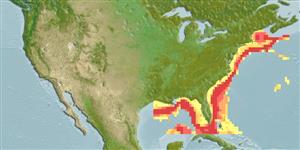Common names from other countries
Environment: milieu / climate zone / depth range / distribution range
Ecologia
; intervalo de profundidade 0 - 2243 m (Ref. 104446). Temperate, preferred 22°C (Ref. 107945); 44°N - 23°N, 94°W - 62°W
Western Atlantic: From Emerald Bank, Nova Scotia, Canada, and the Gulf of Maine to the Mid-Atlantic Bight and the Gulf of Mexico.
Length at first maturity / Tamanho / Peso / Idade
Maturity: Lm ?, range 7 - 9.1 cm Max length : 18.0 cm CW macho/indeterminado; (Ref. 96186); 13.6 cm CW (female)
Adult females do not mate every year. After mating, females carry fertilized eggs on their pleopods for up to 9 months until the larvae are released (Ref. 2765). Brood sizes range from 160,000 to 270,000 eggs, and fecundity increases with female body size (Ref. 2766).
Abellán, L.J.L., E. Balguerías and V. Fernández-Vergaz. 2002. (Ref. 2677)
Status na Lista Vermelha da IUCN (Ref. 130435: Version 2024-1)
Status no CITES (Ref. 108899)
Not Evaluated
Not Evaluated
Uso pelos humanos
Pescarias: espécies comerciais
FAO - pescarias: landings | FishSource | Sea Around Us
Ferramentas
Fontes da internet
Estimates based on models
Preferred temperature
(Ref.
115969): 3.8 - 12.9, mean 6.4 (based on 34 cells).
Vulnerabilidade
Low vulnerability (10 of 100).
